#anuttarayoga
Text
Tantra: Tilopa’s Song of Mahamudra
Explore the profound world of Tantra and the teachings of Tilopa, an Indian Buddhist monk in the tantric Kagyu lineage of Tibetan Buddhism. Delve into the essence of Mahamudra, a set of spiritual practices that accelerate the path to Buddhahood.
Tantra
The Supreme Understanding
Tantra:
The Supreme Understanding
Introduction
Tilopa’s Song of Mahamudra
A deep and insightful look into the underlying ideas of Tantra.
Walking the road to enlightenment by embodying the full acceptance of all that is. A commentary on Tilopa’s marvelous song.
Tilopa,
was an Indian Buddhist monk in the tantric Kagyu lineage of Tibetan Buddhism.
He…

View On WordPress
#6 Yogas of Naropa#Anuttarayoga Tantra#Buddhahood#Buddhist masters#Compassion#Divine Feminine#Essence of teachings#Ganges river#Guru yoga#Kagyu lineage#Mahamudra#Mahamudra Song#Marpa Lotsawa#Naropa#Primordial Buddha#Supreme Understanding#Tantra#tantric buddhist#Tibet#tibetan buddhism#tilopa#Vajradhara#Wisdom#Yogi Milarepa
1 note
·
View note
Text


Tantra is the science of transforming ordinary lovers into soul mates. And that is the grandeur of Tantra. It can transform the whole earth; it can transform each couple into soul mates.
-Rajneesh
Yab-Yum
Talon Abraxas
Yab-Yum (Tibetan meaning "father-mother") is a common symbol in the Buddhist art of India, Bhutan, Nepal and Tibet representing the male deity in sexual union with his female consort. Often the male deity is sitting in lotus position while his consort is sitting in his lap.
The symbolism is associated with Anuttarayoga tantra and, while there are various interpretations of the symbolism in the twilight language, the male figure is usually linked to compassion (karuṇā) and skillful means (upāya-kauśalya), while the female partner to 'insight' (prajñā).
The symbolism of union and sexual polarity is a central teaching Tantric Buddhism, especially in Tibet. The union is realised by the practitioner as a mystical experience within one's own body.
Yab-yum is generally understood to represent the primordial (or mystical) union of wisdom and compassion. In Buddhism the masculine form is active, representing the compassion and skillful means (upaya) that have to be developed in order to reach enlightenment. The feminine form is passive and represents wisdom (prajna), which is also necessary to enlightenment. United, the figures symbolize the union necessary to overcome the veils of Maya, the false duality of object and subject.
Yab-yum may also be represented through the aniconic signification of yantra and mandala. In Tibetan Buddhism, the same ideas are to be found concerning the bell and the dorje, which, like the yab-yum, symbolize the dualism that must be exceeded. The sacred Tantric practice leads to rapid development of mind by using the experience of bliss, non-duality, andecstasy while in communion with one's consort.
71 notes
·
View notes
Text
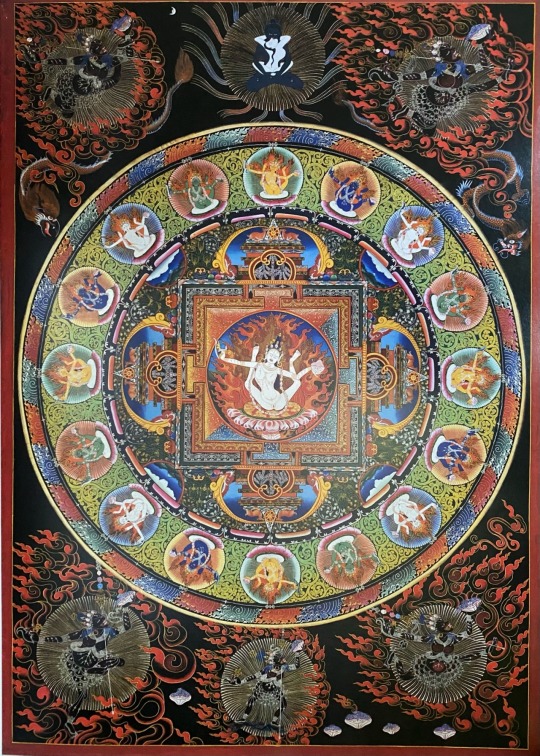
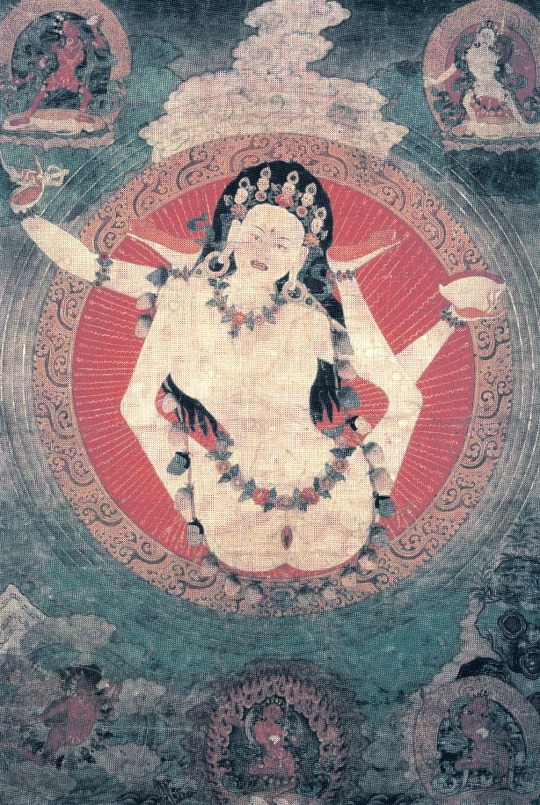

“Dakini Mandala: Gateway to Celestial Bliss” by Romio Shrestha, with text by Ian A. Baker.
From “Celestial Gallery” (2000).
Central image: Sukhasiddhi Dakini
Vajrayogini, is a representation of complete Buddhahood in female form, whose practices are associated with the Chakrasamvara Cycle of Anuttarayoga Tantra.
24 notes
·
View notes
Photo

Ratnasambhava, Buddha a principal buddha within Vajrayana Buddhism representing the qualities of enlightenment and residing in the southern quarter of a mandala.
Ratnasambhava is primarily associated with Vajrayana Buddhism and originates in the Tantric Literature of the Yoga and Anuttarayoga Tantra classes. He is most commonly depicted in the set of the Five Symbolic Buddhas.
8 notes
·
View notes
Text

Ratnasambhava, Buddha a principal buddha within Vajrayana Buddhism representing the qualities of enlightenment and residing in the southern quarter of a mandala.
Ratnasambhava is primarily associated with Vajrayana Buddhism and originates in the Tantric Literature of the Yoga and Anuttarayoga Tantra classes. He is most commonly depicted in the set of the Five Symbolic Buddha's.
#buddha#buddhist#buddhism#dharma#sangha#mahayana#zen#milarepa#tibetan buddhism#thich nhat hanh#amitaba buddha#pure land#vajrayana
15 notes
·
View notes
Photo

Chakrasamvara and Consort ca 17th century. Tibet. Mineral pigments with gold on cloth. Chakrasamvara, which translates to "wheel of bliss," is one of the most popular yidam (meditations deity) in Tantric Buddhism after the 11th century. As the principal deities of the Anuttarayoga Tantra of the Vajrayana Buddhist tradition, Chakrasamvara can appear in several dozen different forms, from simple to complex, peaceful to wrathful. Here, Chakrasamvara and his consort Vajravarahi are both shown in wrathful form, standing over Kalaratri and Black Bhairava, symbolizing triumph over ego and ignorance. (via Instagram: Kapoor Galleries)
234 notes
·
View notes
Text
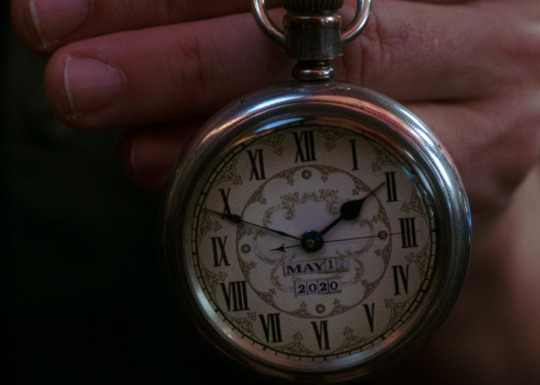




not what i set out to finish, got a bit distracted on other meta ends, but too good to leave sitting in drafts
and no just in case you think that's when they set all their clocks, or it was actual time, no and no. there was a lot of interesting clockwork in 15.01 to begin with, I just tagged my stuff back then poorly

In Manipura and below, man is bound by the laws of karma and fate. In Anahata one makes decisions ("follows one's heart") based on one's higher self, not the unfulfilled emotions and desires of lower nature. As such, it is known as the heart chakra.
It is also associated with love and compassion, charity to others and psychic healing. Meditation on this chakra is said to bring about the following siddhis (abilities): he becomes a lord of speech, he is dear to women, his presence controls the senses of others, and he can leave and enter the body at will.
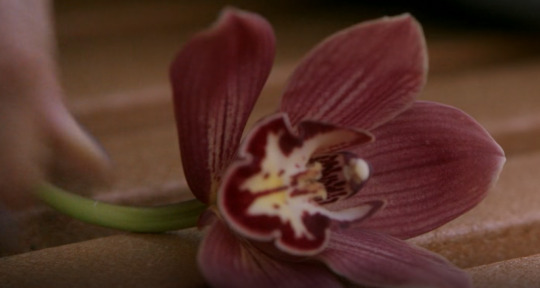



Anahata (Sanskrit: अनाहत, IAST: Anāhata, English: "unstruck") or heart chakra is the fourth primary chakra, according to Hindu Yogic, Shakta and Buddhist Tantric traditions. In Sanskrit, anahata means "unhurt, unstruck, and unbeaten". Anahata Nad refers to the Vedic concept of unstruck sound (the sound of the celestial realm). Anahata is associated with balance, calmness, and serenity.
The name of this chakra signifies the state of freshness that appears when we are able to become detached and to look at the different and apparently contradictory experiences of life with a state of openness (expansion).
Normally we are not used to the effect produced by the confrontation of the two opposite forces. At the level of Anahata chakra appears the possibility to integrate the two opposite forces and obtain the effect (sound, in this case), without the two forces being confronted (without touching of the two parts).
This energy is specific to cooperation and integration, which brings peace and a new perspective in a world which, up to this level (considering only the energies specific to the first three centres of force: Muladhara, Swasdhistana and Manipura) was made only of a more or less conscious confrontation between opposite forces. The name Anahata suggests, in fact, the synergetic effect of the interaction of energies at this level.
Anahata is considered to be a tiny flame inside the heart. associated with the ability to make decisions outside the realm of karma.

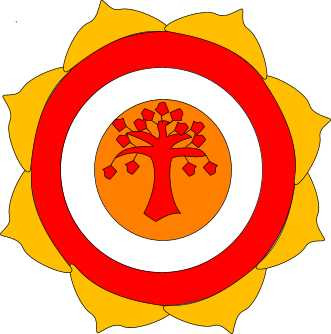
Hrit (Hridaya, Surya) chakra
Tree inside two circles inside a lotus flower
The Hrit chakra (just below Anahata) is the seat of the wish-fulfilling tree.
Immediately below Anahata (at the solar plexus or, sometimes, on the near left side of the body) is a minor chakra known as Hrit (or Hridaya, "heart"), with eight petals.
It has three regions:
a vermilion sun region,
within which is a white moon region,
within which is a deep-red fire region.
Within this is the red wish-fulfilling tree, kalpavriksha, which symbolises the ability to manifest what one wishes to happen in the world.
The heart wheel in Tibetan Buddhism is the location of the indestructible red-and-white drop. At death, the winds of the body dissolve and enter this drop, which then leads the body into Bardo (the intermediate stage) and rebirth. The heart wheel in this model is circular, white and has eight petals (or channels) reaching downwards.
These channels divide into three wheels (mind, speech and body)


The heart wheel is important in meditation; in the lower tantras, the mantra is recited from the heart. It is recited verbally and then mentally;
then, in the heart, a tiny moon disc and flame are imagined from which the mantra rings.
In the higher tantras (the Anuttarayoga Tantra of the Sarma schools) or the Inner Tantras of the Nyingma school, the practitioner attempts to dissolve the winds and drops into the central channel at the level of the heart to experience the Yoga of Clear Light.
#time#watch#swiss watch#spnwin#1x2#1x4#15x15#15x09#15x01#15x20#15x17#1x7#meta#blossom#akrida#arcadia#garden#queen bee
98 notes
·
View notes
Text

Kurukulla has a standard recognized appearance that is very common along with other forms that are less well known. There are numerous forms and lineages of Kurukulla arising from the Kriya and Anuttarayoga classes of Buddhist tantra of the New (Sarma) traditions and many forms from the 'Terma' (Revealed Treasure) discoveries of the Nyingmapa Tradition. She can appear peaceful or semi wrathful and in a range of colours from white, pink and blue to her more typical red colour. In the Kriya tantras she is often portrayed, but not exclusively, as a red power emanation of Tara. .
.
.
.
.
.
#lamathankapaintingschool #bhaktapurdurbarsquare #buddhism #sarma #tradition #tantra #wrathful #peaceful #tara #kurkulla #himalayan #art #thankapainting #redtara #sacred #heritage #livingheritage
19 notes
·
View notes
Text
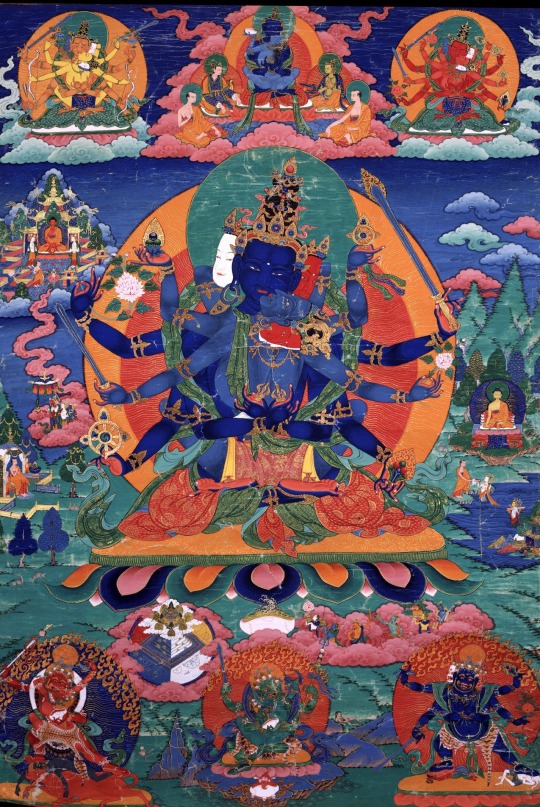
Guhyasamāja Tantra (Part LVI)
Guhyasamja is one of Vajrayana Buddhism’s most fascinating, difficult, and essential personalities. It combines various important tathagata Buddhas, into one image. He is most commonly called Akshobhayavajara which is the form of Akshobhaya buddha.
Guhyasamāja holds a significant position in Tibetan Buddhism as one of the most important deities within the Vajrayana tradition. The word "Guhyasamāja" can be translated as "secret assembly" or "mystic unity." This complex and profound deity embodies the union of wisdom and compassion, embodying the ultimate goal of spiritual awakening.
Guhyasamāja has its roots in ancient Indian Buddhist Tantra, particularly within the broader framework of the Mahayana and Vajrayana traditions. It is believed to have been transmitted to Tibet by the great Indian master Padmasambhava in the 8th century CE. The deity is often depicted in a yab-yum (Tibetan for "father-mother") posture, symbolizing the union of wisdom (represented by the male deity) and compassion (represented by the female deity). Guhyasamāja is portrayed as a transcendent being with multiple heads and arms, adorned with various ornaments, and seated on a lotus throne.
The iconography of Guhyasamāja carries profound symbolism that reflects the core principles of Tibetan Buddhism. The multiple heads and arms represent the deity's enlightened qualities and ability to manifest in various forms to assist sentient beings. The yab-yum posture signifies the non-dualistic nature of reality, where wisdom and compassion are inseparable. Guhyasamāja embodies the union of bliss and emptiness, representing the ultimate state of enlightenment, often referred to as the union of method and wisdom.
The practice of Guhyasamāja is highly esoteric and advanced, primarily undertaken by experienced practitioners under the guidance of qualified teachers. The primary aim of these practices is to transform ordinary experiences into the path of awakening. The empowerment or initiation into the Guhyasamāja practice is a crucial step for practitioners, allowing them to establish a direct connection with the deity's enlightened qualities. Empowerments involve rituals, visualization, mantra recitation, and the cultivation of meditative absorption.
Meditation is an essential component of Guhyasamāja practice. Tibetan Buddhist practitioners engage in various meditation techniques associated with this deity to purify their minds and cultivate wisdom and compassion. One such method is deity yoga, where practitioners visualize themselves as Guhyasamāja, embodying the enlightened qualities of the deity. Through this practice, one aims to dissolve the dualistic perception of self and other, cultivating a deep sense of interconnectedness and compassion.
Tantric rituals play a significant role in Guhyasamāja practice. These rituals involve elaborate ceremonies, including chanting of mantras, visualization, mudras (hand gestures), and the offering of various substances such as flowers, incense, and symbolic offerings. These rituals are performed to invoke the presence of Guhyasamāja and to purify and transform mundane experiences into the path of enlightenment.
Guhyasamāja holds a central position in the Vajrayana tradition of Tibetan Buddhism. The practice of Guhyasamāja is considered an advanced practice.
Guhyasamja is the foremost meditational deity of the Method-father class of Anuttarayoga tantra. Guhyasamaja has two main traditions, the Arya (Nagarjuna) Lineage, and the Jnana (Jnanapada) Lineage.
In general there are three principal iconographic forms of Guhyasamaja within this tradition.
Akshobhyavajra (blue),
Manjuvajra (orange), and
Avalokita (red).
All three of these forms have three faces, six arms, two legs, and embrace a consort. Guhyasamaja can appear as either peaceful or slightly peaceful and slightly wrathful.
Guhyasamāja is blue-black in color, a form of Akshobhya, one of the five transcendent lords. Akshobhyavajra holds a vajra and bell in his first two hands, and other hands hold the symbols of the four other transcendent lords, wheel of Vairocana, and lotus of Amitabha in his right. and the gem of Ratnasambhava and sword of Amoghasiddhi in his left.
The sadana continues:
BLESSING THE BODY, SPEECH, AND MIND JOINTLY
"I become the great Vajradhara in whom all the tathāgatas' three vajras of body, speech, and mind combined inseparably.
Om sarvatathāgatakāyavākcittav ajrasvabhāvātmako 'ham".
The sadhana recitation for this practice is limited to this brief statement. Lineage lamas have described the visualization that relates to it in the following manner. Among the thirty-two deities installed in your body, twenty-three are male deities, namely, the five lineage tathāgatas, the eight bodhisattvas, and the ten wrathful deities. Similarly, nine are female deities-that is, the four divine consorts and the five sense goddesses. Each of the twenty-three male deities emanates countless duplicates of himself who invite countless forms of one of the nine goddesses. Similarly, the four consorts and the five sense goddesses emanate countless duplicates of themselves who invite countless forms of each of the twenty-three male deities, with each goddess inviting the male deities who correspond to their respective lineage.
Thus, while appearing in Vajrasattva's emanation-body form, visualize that each of the body mandala's thirty-two male and female deities emanates countless duplicates of himself or herself, that fill the entirety of space. Each of these multitudes of emanations then invites countless forms of their counterpart female or male deity. After embracing one another, these countless pairs of deities dissolve into one another until they become single pairs of each of the thirty-two deities who position themselves in the space above the circular beam inside the mandala palace, then visualize that you emanate a duplicate of yourself who comes before this assembly of deity pairs and makes a supplication to them. Following this supplication, the deity pairs enter into sexual union
and dissolve into thirty-two portions of a
luminous substance whose essence is bliss-voidness wisdom. These substances dissolve into the corresponding thirty-two body-mandala deities, filling their bodies. The surplus of these substances spill out from the bodies of the body-mandala deities and fill your main body that is appearing in Vajrasattva's form. As this occurs, reflect that you attain the status of the great Vajradhara in whom all the tathāgatas' three vajras of body, speech, and mind are combined inseparably. Then recite the mantra for generating the divine pride in which you reflect, "I am the one whose nature is composed of the body, speech, and mind vajras of all the tathāgatas."
6 notes
·
View notes
Text
Tilopa (988–1069) was an Indian Buddhist tantric mahasiddha who lived along the Ganges River. He practised Anuttarayoga Tantra, a set of spiritual practices intended to accelerate the process of attaining Buddhahood. He became a holder of all the tantric lineages, possibly the only person in his day to do so. In addition to the way of insight and Mahamudra, Tilopa learned and passed on the Way of Methods (today known as the Six Yogas of Naropa) and guru yoga. Naropa is considered his main student.
#tilopa#tibetan buddhist#shambala#ganges#yoga#buddhist#buddhism#tantra#tantric#spirituality#buddha#indu#hinduism#indus valley#gnanayoga#naropa
1 note
·
View note
Text
In the Tibetan classification schema, this tantra is considered to be of the "mother" class of the Anuttarayoga (Unsurpassable yoga) class, also known as the Yoginītantras. These tantras were known for their sexual yogas.[3] The text survives in several Sanskrit and Tibetan manuscripts. There are at least eleven surviving Sanskrit commentaries on the tantra and various Tibetan ones.[4]
The Cakrasamvara mostly comprises rituals and yogic practices which produce mundane siddhis (accomplishments) – such as flight – as well as the supramundane siddhi of awakening. These are achieved through practices such as deity yoga (visualizing oneself as the deity) and the use of mantras.[7]
0 notes
Text


Yab-Yum
Talon Abraxas
Yab-yum (Tibetan meaning "father-mother") is a common symbol in the Buddhist art of India, Bhutan, Nepal and Tibet representing the male deity in sexual union with his female consort. Often the male deity is sitting in lotus position while his consort is sitting in his lap.
The symbolism is associated with Anuttarayoga tantra and, while there are various interpretations of the symbolism in the twilight language, the male figure is usually linked to compassion (karuṇā) and skillful means (upāya-kauśalya), while the female partner to 'insight' (prajñā).
The symbolism of union and sexual polarity is a central teaching Tantric Buddhism, especially in Tibet. The union is realised by the practitioner as a mystical experience within one's own body.
81 notes
·
View notes
Text
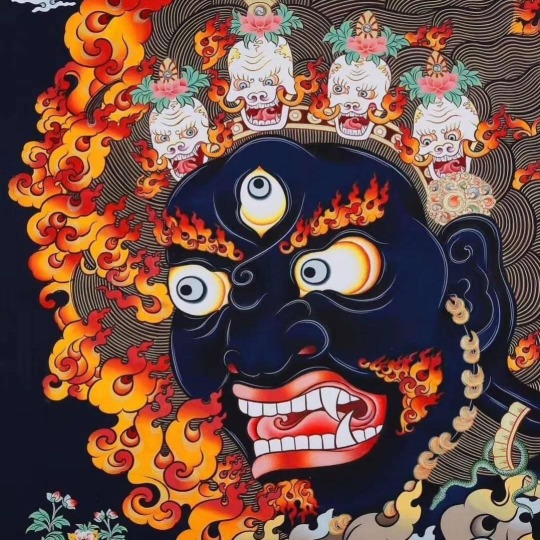
Mahakala (Sanskrit: Mahākāla) is a Dharmapala ("protector of Dharma") in Vajrayana Buddhism (Tibetan, Nepalese Newar, Chinese, Japanese Shingon traditions and related). In Chinese and Japanese Buddhism tradition is known as Daheitian or Daikokuten (大黒天).
Mahakala is a category of Tantric Buddhist deity. His primary function is as a protector (Dharmapala) and specifically the primary Wisdom Protector of Tantric Buddhism - Vajrayana. There are dozens of different variations and forms of Mahakala. He is typically in wrathful appearance following the Indian model of a Raksha demon. In most occurrences and uses of Mahakala, he is paired with a meditational deity such as Panjarnata Mahakala and Shri Hevajra, Chaturbhuja Mahakala and Chakrasamvara, Chaturmukha Mahakala and Guhyasamaja. In most cases Mahakala is an emanation, or wrathful aspect, of the principal meditational deity that he is associated with. For instance Panjarnata Mahakala is the most wrathful emanation, or form, of Hevajra. In other situations Mahakala might be a wrathful emanation of Vajradhara or Akshobhya Buddha. Aside from the individual Anuttarayoga Tantras that teach various forms of Mahakala, the principal texts are the Twenty-five and Fifty Chapter Mahakala Tantra.
In one specific case, Shadbhuja Mahakala, Avalokiteshvara takes on the form of Mahakala. Therefore, it can be said that the Shadbhuja form, with one face and six hands, arising from the Eight Chapter Mahakala Tantra, is a wrathful Avalokiteshvara.
http://en.wikipedia.org/wiki/Mahakala
49 notes
·
View notes
Photo
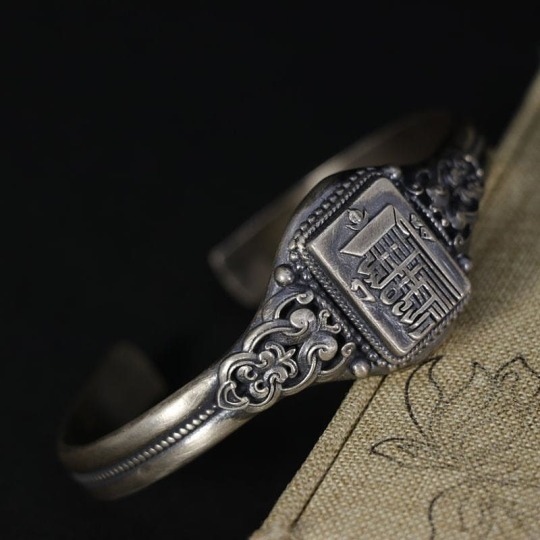
The Kalachakra means "Wheel of Time" in Sanskrit. The Kalachakra is an elaborate explanation of the creation of all matter. It aims to explain that humans are not separate from the universe. But both the universe and human. It is a detailed map of the the inner world (the entire universe) and the outer world (the shell of the universe). And if fully understood and used in the practice of meditation can bring supreme happiness. . 925 Sterling silver Kalachakra cuff-bracelet. . Website link is in the bio. @mantrapiece . #mantrapiece #kalachakra #kalachakramandala #kalachakratemple #kalachakrathangka #tibetanbuddhism #vajrayana #vajrayanabuddhism #vajrayāna #vajrayanabuddhist #vajrayanaart #budismovajrayana #tantra #tantrayoga #tantrayana #tantralife #tantrameditation #mahayana #mahayanabuddhism #sanskrit #buddhahood #wheeloftime #shaivism #vaishnavism #samkhya #madhyamaka #cosmology #kalacakra #anuttara #anuttarayoga (at Los Angeles, California) https://www.instagram.com/p/Ce1tq_kv_4B/?igshid=NGJjMDIxMWI=
#mantrapiece#kalachakra#kalachakramandala#kalachakratemple#kalachakrathangka#tibetanbuddhism#vajrayana#vajrayanabuddhism#vajrayāna#vajrayanabuddhist#vajrayanaart#budismovajrayana#tantra#tantrayoga#tantrayana#tantralife#tantrameditation#mahayana#mahayanabuddhism#sanskrit#buddhahood#wheeloftime#shaivism#vaishnavism#samkhya#madhyamaka#cosmology#kalacakra#anuttara#anuttarayoga
2 notes
·
View notes
Text

Kurukulla has a standard recognized appearance that is very common along with other forms that are less well known. There are numerous forms and lineages of Kurukulla arising from the Kriya and Anuttarayoga classes of Buddhist tantra of the New (Sarma) traditions and many forms from the 'Terma' (Revealed Treasure) discoveries of the Nyingmapa Tradition. She can appear peaceful or semi wrathful and in a range of colours from white, pink and blue to her more typical red colour. In the Kriya tantras she is often portrayed, but not exclusively, as a red power emanation of Tara..
#buddha#buddhist#buddhism#dharma#sangha#mahayana#zen#milarepa#tibetan buddhism#thich nhat hanh#dakini
7 notes
·
View notes
Photo



Chakrasamvara
Gilt Copper Figure of Chakrasamvara. Nepal, 15th/16th Century.
8 5/8 in. (22 cm) high (via Bonhams)
The vision of Twelve-armed Samvara in ecstatic, dance-like embrace with his consort Vajravarahi is one of the most exquisite subjects in Vajrayana Buddhist art. Meaning "Wheel of Bliss" in Sanskrit, the union of the two deities is known as Chakrasamvara, as represented in this near-complete example.
The deities embody the attainment of the Highest Yoga Tantra tradition (Anuttarayoga Tantra) and Tibetan Buddhism's supreme ideal: the skilled union of perfect wisdom (Vajravarahi) and compassion (Samvara).
97 notes
·
View notes